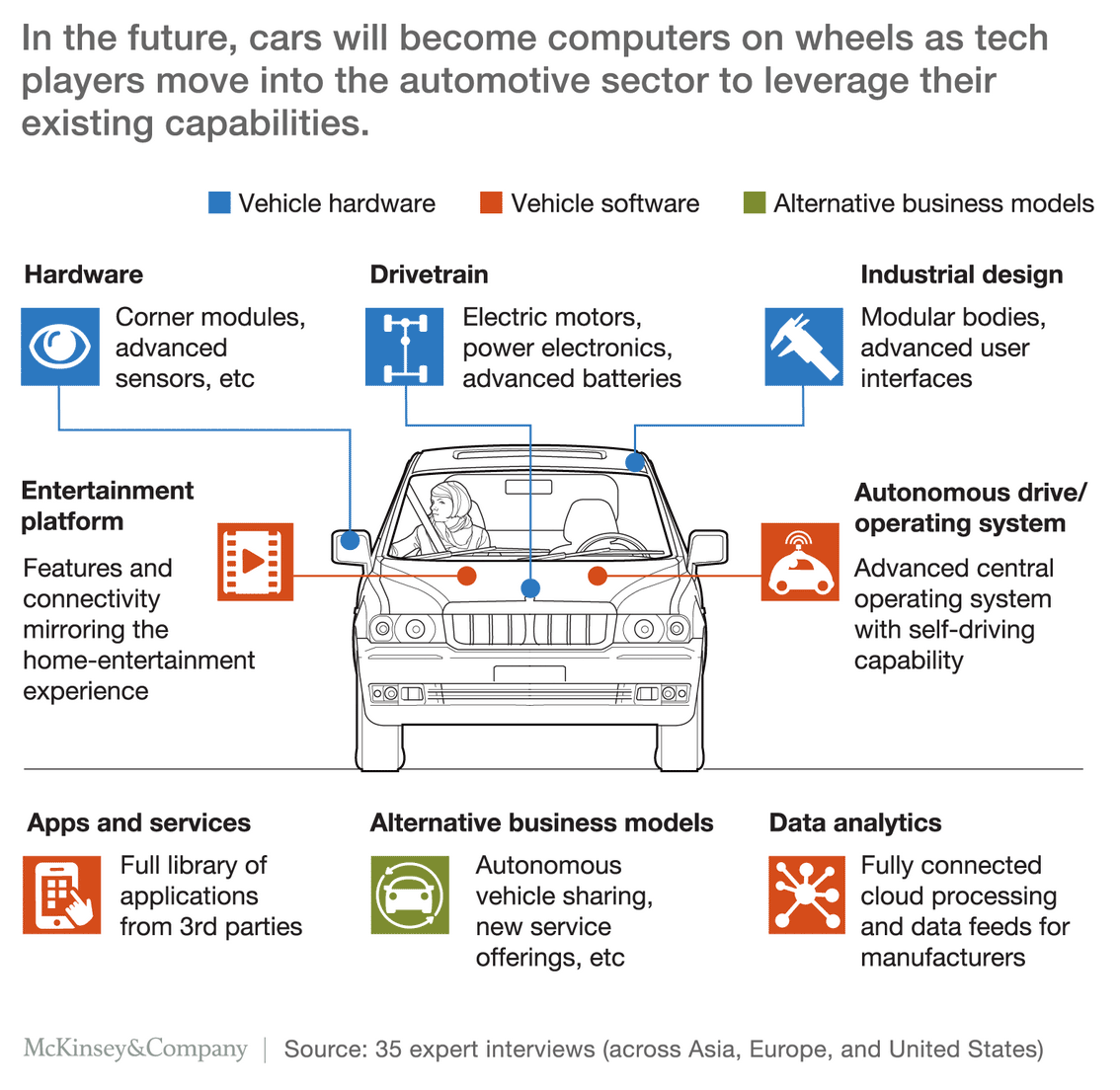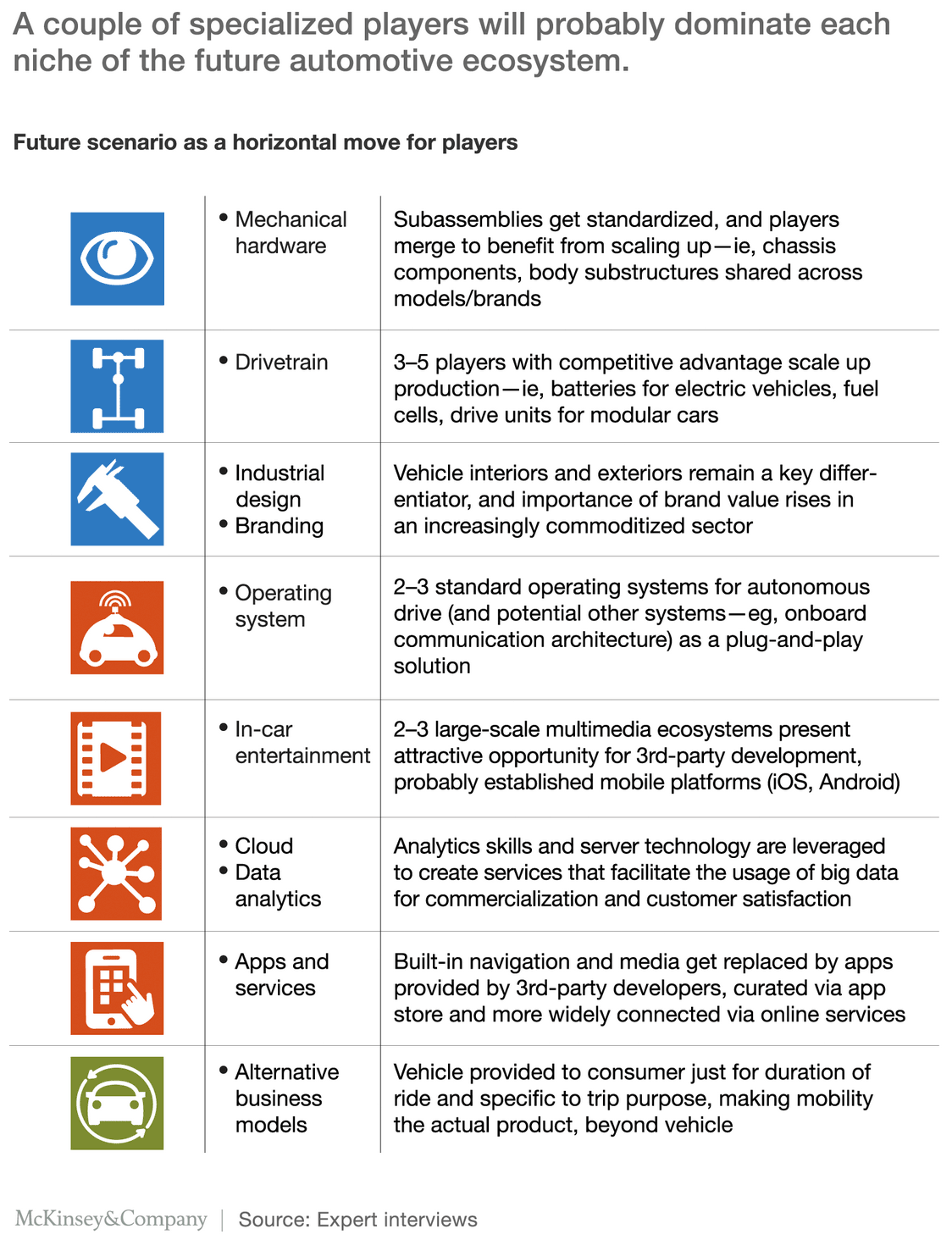How the convergence of automotive and tech will create a new ecosystem
November 26, 2016
![]() By Sven Beiker, Fredrik Hansson, Anders Suneson, and Michael Uhl
By Sven Beiker, Fredrik Hansson, Anders Suneson, and Michael Uhl
As the high-tech and automotive worlds merge—with four disruptive technology trends driving change—a complex ecosystem is creating new rules for success.
As four technology trends reshape the global automotive sector, customer preferences are moving away from its traditional strongholds, such as chassis and engine development. This shift in customer preferences and the sheer size of the automotive sector have attracted new players: a potent mix of large high-tech companies and start-ups. Both differ from the automotive incumbents on virtually every level.
These new entrants and the disruptive trends they bring—electrification, autonomous driving, diverse mobility, and connectivity—will transform typically vertically integrated automotive value chains into a complex, horizontally structured ecosystem. The newcomers are well positioned (and expected) to make moves in novel areas such as autonomous driving. Consequently, today’s OEMs and tier-one suppliers must abandon strategies aiming at total control of vehicles and instead pick and choose where and how to play by shedding assets, streamlining operations, and embracing digital acquisitions.
Four trends that favor software-driven innovation
The fortunes of players in the automotive sector have always depended on what customers see as valuable. Most of this value has resided in the hardware of vehicles and in the automakers’ brands. However, future innovations will probably focus on disruptive technology trends, so the customers’ perceptions of value will shift, increasingly putting incumbents in danger. The four trends that will favor the newcomers are these:
- Electrification. Drivetrains will shift toward hybrid-electric, electric, and fuel-cell technologies as they mature and become cheaper.
- Autonomous driving. The operation of automated cars will move from advanced driver-assistance systems to fully autonomous driving as the technology matures.
- Diverse mobility. As the sharing economy expands and consumer preferences change, the standard model will continue to evolve from outright purchase or lease to rentals and car sharing.
- Connectivity. The possibilities for “infotainment” innovations, novel traffic services, and new business models and services will increase as cars get connected to each other, to the wider infrastructure, and to people.
Attracted by the shift in customer preferences, the importance of the new trends, and the global automotive market’s massive size and value-creation potential, technology players are making their way into the sector. As they develop new software options, cars are evolving into computers on wheels, a change similar to events in the computer industry 20 years ago and the cellphone industry 10 years ago. As a result, we anticipate that a complex ecosystem will emerge in the automotive sector (Exhibit 1).

Although the sector adheres to a vertically integrated business model, with OEMs in full control of their supplier networks, the new tech players are more focused on horizontal moves:
- A number of high-tech players are developing autonomous-driving systems that are quite likely to merge into what the computer industry calls an operating system (the central system that makes a unit run).
- Disruptors from the taxi and ride-sharing industries are developing innovative new business models.
- Two leading online and technology companies are focusing on in-car entertainment platforms, which they hope will become the standard for applications.
No single player is likely to dominate any part of such a horizontally organized, complex value chain by itself. But many of the new tech entrants are well positioned to take the lead in the software-focused parts. For each part of the ecosystem, there might be room for only a few winners, since few players will be able to invest the resources necessary to reach scale (Exhibit 2).

The automakers have invested billions in car hardware, from engine plants to stamping facilities and beyond, so they have the best position to dominate the hardware-focused areas. In software, the tech players enjoy significant advantages, including leading-edge capabilities, agile operating models, and the financial muscle required to pursue exploratory investments aggressively. For the automakers and tech players, success in tomorrow’s mobility sector will depend on how well they build on these natural advantages.
OEMs and suppliers face tough new competition
Many OEMs and tier-one suppliers can see the shift coming but might underestimate how much strategic change they must undergo to be part of the automotive sector’s future: they may lag behind the tech entrants in the asset base, skills, and resources needed to respond to this new competitive environment. Still, it makes sense to assess the readiness of the OEMs and tier-one suppliers, on the one hand, and of the tech players, on the other, in the important indicators of competitiveness: financial flexibility, the deployment of capital and people, operating models, culture, and customer-centricity.
Financial flexibility. Traditional OEMs often have limited financial flexibility as a result of low operating margins, low returns on invested capital (ROIC), and moderate market-capitalization levels. Tech players, in contrast, tend to enjoy high financial agility, with robust operating margins, high ROICs, and large market caps (Exhibit 3).

Some tech companies enjoy valuations ten times higher than those of leading OEMs. As a result, exploratory investments in new disruptive technologies, which might cost as much as 10 percent of a leading OEM’s market cap, would cost only 1 percent of the market caps of the largest tech players. As Wall Street flooded the tech sector with money over the past decade, companies in it have made a high priority of pursuing growth and business opportunities that can justify these valuations. Investors expect such exploratory investments, so tech companies enjoy higher financial flexibility. For many OEMs, by contrast, the top priority is to achieve full asset utilization (given high fixed costs) and to increase volumes of current models. That limits opportunities for exploratory investments.
Deploying capital and people. Automakers command manufacturing and mechanical-engineering assets and have large workforces weighted toward these disciplines. Technology companies focus much more on software and frontline computer assets, such as machine learning, with workforces weighted heavily toward software development (Exhibit 4).

Automakers not uncommonly spend up to 75 percent of their overall capital-expenditure distributions on traditional product-development and manufacturing assets. Tech players instead allocate a similar ratio to software development and the customer experience. The largest technology entrants also spend more on R&D than automakers do—over 10 percent compared with less than 5 percent of their revenues, respectively—and allocate more of this spending to disruptive technologies.
Operating models and culture. Automotive incumbents operate by a rich legacy of sectoral norms and conventions. They often adhere to rigid, rigorous, and unique product-development practices; work with complex supply chains; and sell through extensive franchised retail-dealer networks. The culture of OEMs values consistency, quality, and the minimization of risk. Tech players prefer experimental, fast-moving cultures that reward innovation and risk taking. OEMs have traditionally favored incremental hardware innovations, while tech companies actively seek disruptive software products or services. OEMs use traditional marketing tools and techniques. Tech players tend to be more focused on customers, engaging them early and often.
The operating models of the two sides differ dramatically. For example, automakers reengineer their core products approximately once every seven years, with noticeable updates every three years, but do not update existing products. Tech companies redo their core products about every two years, make noticeable updates every two months, and provide continual updates for existing products. The OEMs’ systematic “waterfall” approach to product development tends to slow down innovation; the average time to market is about five years. Most tech players depend on agile operating models that enable a time to market of roughly two years.
Customer perceptions. Mass-market automotive brands, while strong, often evoke traditional values, such as reliability and efficiency, and thus lack the “coolness factor” that leading tech players enjoy thanks to their reputation for innovation and agility. In fact, tech brands took six of the top ten positions on a recent tally of the world’s most valuable brands; the first automotive one held 28th place.
Future OEM and high-tech automotive strategies
For mass-market OEMs, the emerging strategy is to go all out to build additional scale. This probably means additional consolidation in the sector, and the resulting entities might integrate backwardly to obtain key strategic suppliers. To succeed, OEMs will have to focus strongly on developing and producing market-leading hardware, such as bodies and interiors. They must also increase their margins by embracing digital manufacturing techniques (including 3-D printing and automation), added purchasing power, and the dilution of overhead. These changes would be similar to those undertaken by hardware manufacturers in the mobile-phone industry. In low-margin areas, scale is needed to generate substantial profits.
In contrast, premium OEMs could streamline their platforms to free up capital, shed low-value manufacturing assets to double down on worthwhile hardware attributes (such as look and feel), and provide extensive personalization. Their development efforts should focus on a single new area, such as in-car entertainment, autonomous driving, or mobility services. These companies should also secure partnerships to exploit other disruptive technologies and focus on maintaining their brand strength.
Tech players have several options to enter the sector through horizontal plays. One likely choice is to be a technology supplier focused on new high-tech products but then to evolve into a dominant platform player by acquiring all relevant competing assets, such as infotainment ecosystems or autonomous-driving systems. These companies would partner with OEMs to push products to the market on the backs of solid hardware platforms from the established players, thereby breaking up the vertically oriented structure.
The convergence of the automotive and high-tech sectors will rewrite the rules of competition and lessen the chances of survival for traditional players that fail to act. The competitive space remains fluid at this point, but that could change quickly as incumbents move to position themselves advantageously and tech companies solidify their investment strategies.
About the author(s)
Sven Beiker is a specialist in McKinsey’s Silicon Valley office, where Michael Uhl is a partner; Fredrik Hansson is an associate partner in the Gothenburg office, and Anders Suneson is a consultant in the Stockholm office.
The authors wish to thank Johan Ahlberg, Daniel Anger, Nicholas Clift, Tim Koller, Varun Marya, Armen Mkrtchyan, Detlev Mohr, Timo Möller, Asutosh Padhi, and Katie Znameroski for their contributions to this article.




























